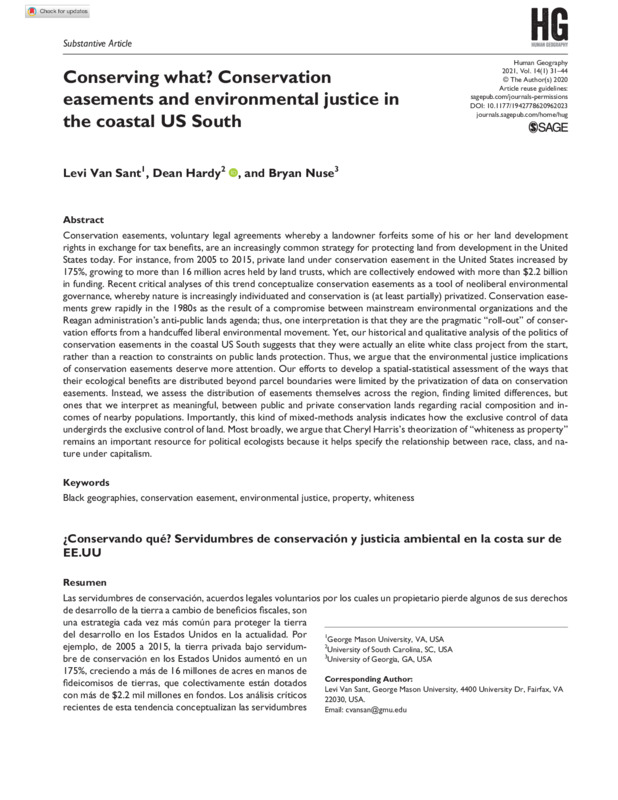Conserving What? Conservation Easements and Environmental Justice in the Coastal US South
Item
-
Title
-
Conserving What? Conservation Easements and Environmental Justice in the Coastal US South
-
Repository
-
Human Geography
-
Date Created
-
3/1/2021
-
Creator
-
Levi Van Sant, Dean Hardy, and Bryan Nuse
-
Index/Partial Transcript
-
Abstract:
Conservation easements, voluntary legal agreements whereby a landowner forfeits some of his or her land development rights in exchange for tax benefits, are an increasingly common strategy for protecting land from development in the United States today. For instance, from 2005 to 2015, private land under conservation easement in the United States increased by 175%, growing to more than 16 million acres held by land trusts, which are collectively endowed with more than $2.2 billion in funding. Recent critical analyses of this trend conceptualize conservation easements as a tool of neoliberal environmental governance, whereby nature is increasingly individuated and conservation is (at least partially) privatized. Conservation easements grew rapidly in the 1980s as the result of a compromise between mainstream environmental organizations and the Reagan administration’s anti-public lands agenda; thus, one interpretation is that they are the pragmatic “roll-out” of conservation efforts from a handcuffed liberal environmental movement. Yet, our historical and qualitative analysis of the politics of conservation easements in the coastal US South suggests that they were actually an elite white class project from the start, rather than a reaction to constraints on public lands protection. Thus, we argue that the environmental justice implications of conservation easements deserve more attention. Our efforts to develop a spatial-statistical assessment of the ways that their ecological benefits are distributed beyond parcel boundaries were limited by the privatization of data on conservation easements. Instead, we assess the distribution of easements themselves across the region, finding limited differences, but ones that we interpret as meaningful, between public and private conservation lands regarding racial composition and incomes of nearby populations. Importantly, this kind of mixed-methods analysis indicates how the exclusive control of data undergirds the exclusive control of land. Most broadly, we argue that Cheryl Harris’s theorization of “whiteness as property” remains an important resource for political ecologists because it helps specify the relationship between race, class, and nature under capitalism.
-
Research Themes
-
Culture of conservation
Racial inequalities in conservation
Myth of progress
Conservation Easements
Culture of Conservation
Racial inequalities in conservation
Tax benefits of conservation easements
Displacement
-
Bibliographic Citation
-
Van Sant, Levi, Dean Hardy, and Bryan Nuse. “Conserving What? Conservation Easements and Environmental Justice in the Coastal US South.” Human Geography 14, no. 1 (March 1, 2021): 31–44. https://doi.org/10.1177/1942778620962023.

